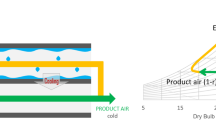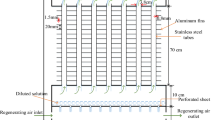Abstract
Liquid desiccant air conditioning system with natural convection was presented previously as a new generation of AC systems. The system consists of two three-fluid energy exchangers namely absorber and regenerator in which the action of air dehumidifying and desiccant regeneration is done, respectively. The influence of working parameters on system performance including the heat source and heat sink temperature, concentration of desiccant solution fills the system initially and humidity content of inlet air to regenerator is investigated experimentally. The heat source temperatures of 50 °C and 60 °C, heat sink temperatures of 15 °C and 20 °C and desiccant concentrations of 30% and 34%, are examined here. The inlet air to regenerator has temperature of 38.5 °C and three relative humidity of 14%, 38% and 44%. In all experiments, the inlet air to absorber has temperature of 31 °C and relative humidity of 75%. By inspecting evaluation indexes of system, it is revealed that higher startup desiccant concentration solution is more beneficial for all study cases. It is also observed although the highest/lowest temperature heat source/heat sink is most suitable for best system operation, increasing the heat source temperature should be accompanied with decreasing heat sink temperature. Using drier air stream for regenerator inlet does not necessarily improve system performance; and the air stream with proper value of humidity content should be employed. Finally after running the system in its best working condition, the coefficient of performance (COP) reached 4.66 which verified to be higher than when the same air conditioning task done by a conventional vapor compression system, in which case the COP was 3.38.




Similar content being viewed by others
Abbreviations
- AC :
-
Air conditioning
- CC :
-
Cooling capacity (W)
- COP :
-
Coefficient of performance
- HR :
-
Humidity ratio (g rmoisture .kg air −1 )
- H/M :
-
Heat and mass
- IAQ :
-
Indoor air quality
- LAMEE :
-
Liquid to air membrane energy exchanger
- LDAC :
-
Liquid desiccant air conditioning
- MRR :
-
Moisture removal rate
- PIV :
-
Particle image velocimetry
- RAMEE :
-
Run around membrane energy exchanger
- RH :
-
Relative humidity; mass of water vapor in air related to its saturation condition
- SHR :
-
Sensible heat ratio
- VCS :
-
Vapor compression refrigeration system
- abs :
-
Absorber (dehumidifier).
- amb :
-
Ambient condition.
- cw :
-
Cold water.
- db :
-
Dry bulb.
- deh :
-
Dehumidifier.
- comp :
-
Air compressor.
- down :
-
Lower junction of the loop.
- ev :
-
Evaporator.
- hw :
-
Hot water.
- in :
-
Inlet fluid flow.
- lat :
-
Latent.
- out :
-
Outlet fluid flow.
- reg :
-
Regeneration.
- sen :
-
Sensible.
- tot :
-
Total.
- up :
-
Upper junction of the loop.
- w :
-
Water.
- A :
-
Study case 1.
- B :
-
Study case 2.
- c :
-
Specific heat capacity (kJ.kg −1 .K −1 ).
- C :
-
Concentration (kg salt .kg sol −1 ).
- E :
-
Power(kW).
- \( \dot{m} \) :
-
Mass flow rate (kg.s −1 ).
- P :
-
Pressure (kPa).
- \( \dot{Q} \) :
-
Heat transfer rate (W).
- T :
-
Temperature ( o c).
- Δ :
-
Difference.
- ω :
-
Humidity ratio.
References
ASHRAE. (2008) HVAC Systems and Equipment HandbookAir-to-Air Energy Recovery, Atlanta, pp 10–16
Bergman TL, Incropera FP (2011) Fundamentals of heat and mass transfer John Wiley & Sons
Erb B, Ahmadi MS, Simonson CJ, Besant RW (2009) Experimental Measurements of a Run-Around Membrane Energy Exchanger (RAMEE) with Comparison to a Numerical Model. ASHRAE Trans 115
Fan H, Simonson CJ, Besant RW, Shang W (2006) Performance of a run-around system for HVAC heat and moisture transfer applications using cross-flow plate exchangers coupled with aqueous lithium bromide. HVAC&R Research 12:313–336
Fazilati MA, Sedaghat A, Alemrajabi AA (2016) Natural induced flow due to concentration gradient in a liquid desiccant air dehumidifier. Appl Therm Eng 105:105–117
Fazilati MA, Sedaghat A, Alemrajabi A-A (2017) Transient performance and temperature field of a natural convection air dehumidifier loop. Heat Mass Transf:1–10
Fazilati MA, Alemrajabi AA, Sedaghat A (2017) Liquid desiccant air conditioning system with natural convection. Appl Therm Eng 115:305–314
Ge G, Moghaddam DG, Abdel-Salam AH, Besant RW, Simonson CJ (2014) Comparison of experimental data and a model for heat and mass transfer performance of a liquid-to-air membrane energy exchanger (LAMEE) when used for air dehumidification and salt solution regeneration. Int J Heat Mass Transf 68:119–131
Hemingson HB, Simonson CJ, Besant RW (2011) Steady-state performance of a run-around membrane energy exchanger (RAMEE) for a range of outdoor air conditions. Int J Heat Mass Transf 54:1814–1824
Isetti C, Nannei E, Magrini A (1997) On the application of a membrane air—liquid contactor for air dehumidification. Energy and Buildings 25:185–193
Jain S, Tripathi S, Das RS (2011) Experimental performance of a liquid desiccant dehumidification system under tropical climates. Energy Convers Manag 52:2461–2466
Lowenstein A (2008) Review of liquid desiccant technology for HVAC applications. Hvac&R Research 14:819–839
Mahmud K, Mahmood GI, Simonson CJ, Besant RW (2010) Performance testing of a counter-cross-flow run-around membrane energy exchanger (RAMEE) system for HVAC applications. Energ. Buildings 42:1139–1147
Ren CQ (2008) Effectiveness–NTU relation for packed bed liquid desiccant–air contact systems with a double film model for heat and mass transfer. Int J Heat Mass Transf 51:1793–1803
Seyed-Ahmadi M, Erb B, Simonson CJ, Besant RW (2009) Transient behavior of run-around heat and moisture exchanger system. Part І: Model formulation and verification. Int. J. Heat Mass Transf. 52:6000–6011
Simonson C, Besant R (1999) Energy wheel effectiveness: part I—development of dimensionless groups. Int J Heat Mass Transf 42:2161–2170
Vali A, Simonson CJ, Besant RW, Mahmood G (2009) Numerical model and effectiveness correlations for a run-around heat recovery system with combined counter and cross flow exchangers. Int J Heat Mass Transf 52:5827–5840
World energy outlook 2012 (2012): executive summary International energy agency (IEA)
Zhang L-Z (2010) An analytical solution for heat mass transfer in a hollow fiber membrane based air-to-air heat mass exchanger. J Membr Sci 360:217–225
Zhang L, Zhu D, Deng X, Hua B (2005) Thermodynamic modeling of a novel air dehumidification system. Energ. Buildings 37:279–286
Zhang L-Z, Huang S-M, Pei L-X (2012) Conjugate heat and mass transfer in a cross-flow hollow fiber membrane contactor for liquid desiccant air dehumidification. Int J Heat Mass Transf 55:8061–8072
Zhang L-Z, Huang S-M, Chi J-H, Pei L-X (2012) Conjugate heat and mass transfer in a hollow fiber membrane module for liquid desiccant air dehumidification: a free surface model approach. Int J Heat Mass Transf 55:3789–3799
Author information
Authors and Affiliations
Corresponding author
Ethics declarations
Conflict of interest
On behalf of all authors, the corresponding author states that there is no conflict of interest.
Rights and permissions
About this article
Cite this article
Fazilati, M.A., Alemrajabi, A.A. & Sedaghat, A. Natural convection liquid desiccant loop as an auxiliary air conditioning system: investigating the operational parameters. Heat Mass Transfer 54, 903–913 (2018). https://doi.org/10.1007/s00231-017-2191-4
Received:
Accepted:
Published:
Issue Date:
DOI: https://doi.org/10.1007/s00231-017-2191-4




